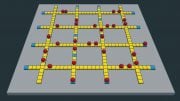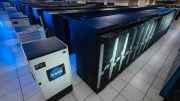
A group of scientists at the U.S. Department of Energy’s Ames Laboratory has developed computational quantum algorithms that are capable of efficient and highly accurate simulations of static and dynamic properties of quantum systems. The algorithms are valuable tools to gain greater insight into the physics and chemistry of complex materials, and they are specifically designed to work on existing and near-future quantum computers.
Scientist Yong-Xin Yao and his research partners at Ames Lab use the power of advanced computers to speed discovery in condensed matter physics, modeling incredibly complex quantum mechanics and how they change over ultra-fast timescales. Current high performance computers can model the properties of very simple, small quantum systems, but larger or more complex systems rapidly expand the number of calculations a computer must perform to arrive at an accurate model, slowing the pace not only of computation, but also discovery.
“This is a real challenge given the current early-stage of existing quantum computing capabilities,” said Yao, “but it is also a very promising opportunity, since these calculations overwhelm classical computer systems, or take far too long to provide timely answers.”
The new algorithms tap into the capabilities of existing quantum computer capabilities by adaptively generating and then tailoring the number and variety of “educated guesses” the computer needs to make in order to accurately describe the lowest-energy state and evolving quantum mechanics of a system. The algorithms are scalable, making them able to model even larger systems accurately with existing current “noisy” (fragile and prone to error) quantum computers, and their near-future iterations.
“Accurately modeling spin and molecular systems is only the first part of the goal,” said Yao, “In application, we see this being used to solve complex materials science problems. With the capabilities of these two algorithms, we can guide experimentalists in their efforts to control materials’ properties like magnetism, superconductivity, chemical reactions, and photo-energy conversion.”
“Our long-term goal is to reach ‘quantum advantage’ for materials— to utilize quantum computing to achieve capabilities that cannot be achieved on any supercomputer today,” said Ames Laboratory Scientist Peter Orth.
This topic is further discussed in two papers: (1)“Adaptive Variational Quantum Dynamics Simulation,” authored by Y.-X. Yao, N. Gomes, F. Zhang, C.-Z. Wang, K.-M. Ho, T. Iadecola, and P. P. Orth; and published in PRX Quantum; (2) “Adaptive Variational Quantum Imaginary Time Evolution Approach for Ground State Preparation,” authored by N. Gomes, A. Mukherjee, F. Zhang, T. Iadecola, C.-Z. Wang, K.-M. Ho, P. P. Orth, Y.-X. Yao; accepted in Advanced Quantum Technologies.
Ames Laboratory is a U.S. Department of Energy Office of Science National Laboratory operated by Iowa State University. Ames Laboratory creates innovative materials, technologies and energy solutions. We use our expertise, unique capabilities and interdisciplinary collaborations to solve global problems.
Ames Laboratory is supported by the Office of Science of the U.S. Department of Energy. The Office of Science is the single largest supporter of basic research in the physical sciences in the United States, and is working to address some of the most pressing challenges of our time.









Be the first to comment on "Innovative New Algorithms Advance the Computing Power of Early-Stage Quantum Computers"